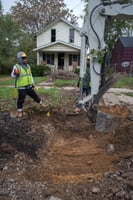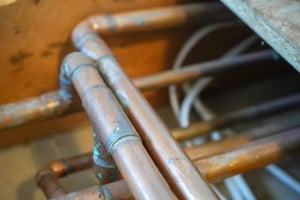Building trust within your community through effective communication and education about lead...
Unpacking the Lead and Copper Rule Improvements Proposal:Timeline, Key Aspects, Requirements and Deadlines
The EPA (U.S. Environmental Protection Agency) has proposed updates to the Lead and Copper Rule Revisions (LCRR) to better protect against lead in drinking water. The aim is to simplify regulations, enhance corrosion control, increase public education, and improve safety in schools and childcare facilities.
The proposal highlights the health risks of lead exposure, such as neurodevelopmental issues in children and cardiovascular problems in adults. It stresses the need for equitable service line replacement and greater transparency. It also suggests updated service line inventories, replacement plans for homes with lead plumbing, and a revised analysis of the rule’s benefits, costs, and compliance timelines.
This article discusses proposed updates to the Lead and Copper Rule by the EPA, aiming to enhance the protection against lead in drinking water. It outlines the transition from the original Lead and Copper Rule established in 1991, through its revisions in 2020, to the current improvement proposal.
For an in-depth review of the National Primary Drinking Water Regulations for Lead and Copper Improvements (LCRI), read here.
Timeline and Key Aspects of LCR, LCRR and LCRI:
Lead and Copper Rule (LCR): Established in 1991
- Introduced an action level of 0.015 mg/L (milligrams per liter) for lead and 1.3 mg/L for copper.
- Required water systems to monitor drinking water at customer taps.
- If action levels are exceeded, systems must take steps such as corrosion control treatment, source water treatment, public education, and lead service line replacement.
Lead and Copper Rule Revisions (LCRR): Finalized in December 2020
- Maintains the same action levels but introduces a new lead trigger level of 0.010 mg/L to prompt more proactive actions.
- Requires testing in schools and childcare facilities.
- Introduces a requirement for water systems to create and maintain a public inventory of lead service lines.
- Promotes full lead service line replacement rather than partial replacements.
- Mandates completion of an initial Service Line Inventory by October 16, 2024
- Mandates notification of customers about service line materials within 30 days of inventory completion; i.e., November 14, 2024.
Lead and Copper Rule Improvements (LCRI) Proposal:
- Aims to reduce the complexity of the rule and includes provisions for more efficient implementation by water systems.
- Proposes to lower the lead action level to 0.010 mg/L and eliminate the lead trigger level to simplify the rule and prompt earlier action.
- Systems with continually high lead levels would need to conduct additional outreach and make filters available to consumers.
- Introduces an updated tap sampling protocol for better representation of stagnant water in the service line and plumbing.
- Simplifies the process by deferring the optimal corrosion control treatment for systems that can remove 100% of lead and galvanized requiring replacement (GRR) service lines within five years
- Aims to increase transparency and inform the public about lead exposure through improved public education requirements.
Each subsequent rule and proposal (LCR -> LCRR -> LCRI) aims to be more proactive and protective of public health by lowering action levels, improving transparency, and requiring more stringent actions from water systems.
Key Aspects for the Lead and Copper Rule Improvements (LCRI)
If the LCRI goes into effect, it will represent a significant step forward in safeguarding public health by addressing lead in drinking water. By focusing on simplifying regulations, enhancing public education, and accelerating service line replacement, the LCRI aims to ensure safer drinking water for communities across the United States.
- Simplifying Compliance and Enhancing Transparency
One of the primary goals of the LCRI is to reduce the complexity of regulations, making compliance more manageable for water systems. By introducing more explicit guidelines and more stringent standards, the LCRI seeks to streamline the process of identifying and replacing lead service lines (LSLs) and galvanized requiring replacement (GRR) service lines. Mandatory public access to service line replacement plans and transparent communication about lead levels are integral aspects of the LCRI, ensuring that communities are informed about the safety of their drinking water.
- Accelerating Lead Service Line Replacement
Mandatory full-service line replacement programs are to be implemented for systems with lead, GRR, or unknown service lines within a 10-year timeframe, with deferred deadlines based on replacement rates and system size eligibility. Systems must adhere to a minimum average annual replacement rate of 10 percent, calculated across a rolling 3-year period, unless subject to a shortened or deferred deadline.
All systems are required to conduct thorough reviews of their records to identify connector materials, ensuring the inclusion of lead connectors in their baseline inventory by the designated compliance date.
Additionally, each service line within the inventory must be associated with a street address, with updates conducted annually. It is imperative that systems promptly respond to customer inquiries regarding incorrect material categorizations, ensuring resolution within a 60-day timeframe.
Validation of non-lead service line accuracy must occur within 7 years, or sooner if determined feasible by the state. Moreover, systems must diligently identify all unknown service lines by the mandatory replacement deadline.
Furthermore, in compliance with the replacement plan guidelines, systems must not only develop a comprehensive service line replacement strategy but also inform customers, address legal requirements, and make the plan publicly accessible, especially online for systems serving over 50,000 individuals.
- Supporting Communities and Ensuring Equity
The LCRI recognizes the importance of supporting disadvantaged communities in addressing lead and copper exposure. The Bipartisan Infrastructure Law allocates significant funding for lead service line replacement, while initiatives like the Lead Service Line Replacement Accelerators aid communities in accessing funding and implementing replacement plans. Federal programs such as the Water Infrastructure Finance and Innovation Act (WIFIA) also provide low-cost loans for water infrastructure projects, further supporting lead remediation efforts.
- Enhancing Public Education and Outreach
Public education and transparency are central to the success of the LCRI. Water systems must engage in outreach activities to inform the public about lead levels, replacement plans, and risk mitigation measures. By providing consumers with timely and accurate information about their drinking water, the LCRI empowers communities to take proactive steps to protect their health.
- Addressing Challenges and Ensuring Feasibility
The LCRI acknowledges the challenges associated with lead service line replacement, including workforce shortages and supply chain disruptions. However, the rule provides flexibility in addressing temporary obstacles while focusing on achieving 100% replacement of lead service lines. By leveraging market forces, proactive planning efforts, and community engagement, the LCRI aims to overcome these challenges and ensure the timely replacement of lead service lines nationwide.
Key Deadlines and Requirements of the Proposed LCRI
-
Lead Service Line Replacement (LSLR) Deadline:
- The proposed LCRI would lower the lead action level from 0.015 mg/L to 0.010 mg/L. Water systems must replace lines annually to achieve a 10% replacement rate and meet the 10-year replacement requirement.
- All lead and galvanized requiring replacement (GRR) lines must be replaced within 10 years.
-
Compliance Deadline:
- Water systems are required to comply with the LCRI within three years of the final rule being implemented.
- An extension of up to two years may be granted for systems needing capital improvements.
-
Tap Sampling Frequency:
- The timing for standard tap sampling remains every six months, with the option for triennial monitoring for compliant small and medium systems.
- Systems must collect paired first- and fifth-liter samples at LSL sites to identify high-risk locations for lead.
-
Public Education and Outreach:
- Water systems failing to meet the mandatory service line replacement rate must conduct annual outreach activities until compliance is achieved.
- Larger systems must engage in specific outreach activities, while smaller systems have more flexible options.
-
Service Line Inventory Deadline:
- Systems must categorize all unknown service lines by their mandatory full-service line replacement deadline. Under the LCRR, water systems must develop an initial inventory, make publicly available, and submit it to the State by October 16, 2024.
- Water systems must update their inventory annually or triennially based on their tap sampling frequency. The initial and updated inventories under the LCRR must categorize each service line connected to the public water system as lead, GRR, non-lead, or lead status unknown (also referred to as “unknown”).
- LCRR did not establish a deadline for requiring water systems to determine the lead status of any unknown lines in the inventory.
- EPA is not proposing to change the initial inventory compliance date of October 16, 2024, to ensure that systems make continued progress toward inventory.
-
Lead Action Level and Compliance:
- The lead action level is lowered to 0.010 mg/L, requiring quicker action from water systems.
- Water systems must use samples from all LSL sites to calculate the 90th percentile lead value.
-
Corrosion Control Treatment (CCT):
- Water systems must implement corrosion control treatment methods.
- For small systems, options include optimal corrosion control treatment, LSLR within 15 years, point-of-use treatment, or lead-bearing plumbing replacement.
-
Public Information and Transparency:
- Water systems must include street addresses for service lines and connectors in the publicly accessible inventory to enhance transparency and awareness of lead risks in drinking water.
- Larger systems must make their replacement plans publicly available online to facilitate community engagement and transparency.
These deadlines and requirements outlined by the LCRI are designed to expedite the replacement of lead service lines, enhance public education, and ensure drinking water safety for communities across the United States. Compliance with these regulations is crucial for protecting public health and reducing exposure to lead in drinking water systems.
Copper has been the preferred water service line material for over a century due to its durability, versatility, and reliability. The most common service line material is Type K annealed (soft) copper tube. Copper is impermeable, maintaining water quality by preventing contamination and inhibiting microbial growth, thereby promoting health. It is resistant to corrosion, high pressure, and stress and unaffected by UV rays and disinfectants, minimizing failure risks. Copper is also fully recyclable, supporting a sustainable economy. As a lead-free option, it's ideal for safe, durable water service lines.
To learn why copper is the right choice for water service lines, visit https://copper.org/applications/plumbing/water_service/.


.png?height=200&name=Heading%20(1).png)
